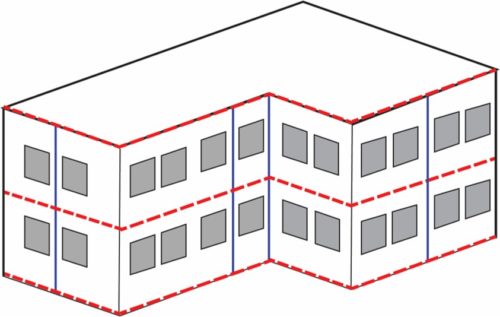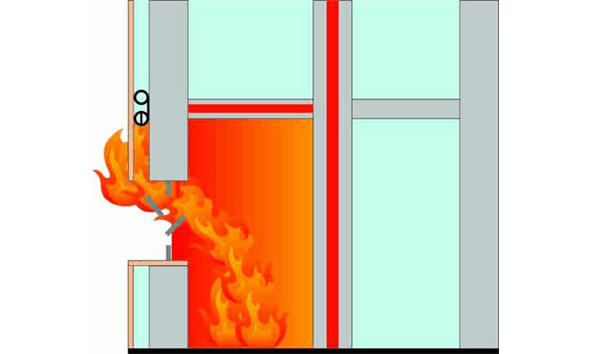
----------- Ventilated fire stop
_______ Non-ventilated fire
Fire compartmentation of the facade
Just like fire cells inside a building, façade compartmentation prevents fire from spreading in the facade and eventually to the entire building.
A façade can be divided into fire compartments by using ventilated cavity barriers at floor level, ensuring that normal ventilation of the façade is maintained and at the same time ensuring effective fire protection.
Non-ventilated fire stops would be installed vertically.
Here we see how the Firebreather® cavity barrier stops the fire from spreading to the floor above while maintaining the necessary ventilation for the facade.
This means that the fire can only spread on the outside of the facade, which is often less critical compared to a fire that spreads in the cavity. Fire in the cavity behind the cladding can spread 5-10 times faster than on the outside, with a speed up to 8 meters per minute.

What is the concept of cavity compartmentation?
The volume of a cavity compartment is confined by the cladding panels, cavity barriers and windscreen, or exposed insulation. Cavity compartments are designed to limit the extent of hidden fire in a façade to an area where fire can self-extinguish, or to give a more controlled access for firemen either through the cladding panels, or through the insulating wall from the inside of the building.
Role of barriers in cavity compartmentation
Cavity barriers prevent fire from entering the cavity of rainscreens and from bypassing fire-separating elements like floors. A cavity can be as large as the wall itself, so it is most often sub-divided into cavity compartments.
A cavity compartment usually coincides with the extent of fire compartmentation of rooms inside. It is cavity barriers that make cavity compartmentation possible. Typically 25 or 50mm deep, they cover the cross section of a fire compartment inside. Cavity compartments can be fairly small, or span vertically from the bottom sill to the top of the wall, depending on the fire strategy. They typically cover from 10 square meters up to a few hundred square meters.
Working principle of 30 minutes external wall cavity compartmentation
Left: 0 – 30 minutes: External fire Middle: 60 minutes: Hidden fire contained within cavity compartment 1 Right: 90 minutes :Hidden fire contained within cavity compartment 1 and 2

